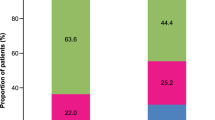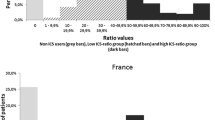Abstract
Background: Underuse of controller therapy among Medicaid-enrolled children is common and leads to more emergency department (ED) visits and hospitalizations. However, there is little evidence about the relationship between medication adherence, outcomes and costs once controller therapy is initiated.
Objective: This study examined the relationship between adherence to two commonly prescribed anti-inflammatory medications, inhaled corticosteroids (ICS) and leukotriene inhibitors (LI), and healthcare utilization and expenditures among children enrolled in Medicaid and the Children’s Health Insurance Program in Florida and Texas in the US.
Methods: The sample for this retrospective observational study consisted of 18456 children aged 2–18 years diagnosed with asthma, who had been continuously enrolled for 24 months during 2004–7 and were on monotherapy with ICS or LI. State administrative enrolment files were linked to medical claims data. Children were grouped into three adherence categories based on the percentage of days per year they had prescriptions filled (medication possession ratio). Bivariate and multivariable regression analyses that adjusted for the children’s demographic and health characteristics were used to examine the relationship between adherence and ED visits, hospitalizations, and expenditures.
Results: Average adherence was 20% for ICS-treated children and 28% for LI-treated children. Children in the highest adherence category had lower odds of an ED visit than those in the lowest adherence category (p < 0.001). We did not detect a statistically significant relationship between adherence and hospitalizations; however, only 3.7% of children had an asthma-related hospitalization. Overall asthma care expenditures increased with greater medication adherence.
Conclusions: Although greater adherence was associated with lower rates of ED visits, higher medication expenditures outweighed the savings. The overall low adherence rates suggest that quality improvement initiatives should continue to target adherence regardless of the class of medication used. However, low baseline hospitalization rates may leave little opportunity to significantly decrease costs through better disease management, without also decreasing medication costs.









Similar content being viewed by others
References
Bloom B, Cohen RA, Freeman G. Summary health statistics for U.S. children: national health interview survey, 2008. Vital Health Stat 2009; 10 (244): 1–81
Adams RJ, Fuhlbrigge A, Finkelstein JA, et al. Impact of inhaled antiinflammatory therapy on hospitalization and emergency department visits for children with asthma. Pediatrics 2001 Apr; 107 (4): 706–11
Balkrishnan R, Norwood GJ, Anderson A. Outcomes and cost benefits associated with the introduction of inhaled corticosteroid therapy in a medicaid population of asthmatic patients. Clin Ther 1998 May-Jun; 20 (3): 567–80
Smith MJ, Rascati KL, McWilliams BC. Inhaled antiinflammatory pharmacotherapy and subsequent hospitalizations and emergency department visits among patients with asthma in the Texas Medicaid program. Ann Allergy Asthma Immunol 2004 Jan; 92 (1): 40–6
Finkelstein JA, Barton MB, Donahue JG, et al. Comparing asthma care for Medicaid and non-Medicaid children in a health maintenance organization. Arch Pediatr Adolesc Med 2000 Jun; 154 (6): 563–8
Ortega AN, Belanger KD, Paltiel AD, et al. Use of health services by insurance status among children with asthma. Med Care 2001 Oct; 39 (10): 1065–74
David C. Preventive therapy for asthmatic children under Florida Medicaid: changes during the 1990s. J Asthma 2004 Sep; 41 (6): 655–61
Sherman J, Patel P, Hutson A, et al. Adherence to oral montelukast and inhaled fluticasone in children with persistent asthma. Pharmacotherapy 2001 Dec; 21 (12): 1464–7
Adams RJ, Fuhlbrigge A, Finkelstein JA, et al. Use of inhaled anti-inflammatory medication in children with asthma in managed care settings. Arch Pediatr Adolesc Med 2001 Apr; 155 (4): 501–7
Butz AM, Tsoukleris M, Donithan M, et al. Patterns of inhaled antiinflammatory medication use in young underserved children with asthma. Pediatrics 2006 Dec; 118 (6): 2504–13
Finkelstein JA, Lozano P, Farber HJ, et al. Underuse of controller medications among Medicaid-insured children with asthma. Arch Pediatr Adolesc Med 2002 Jun; 156 (6): 562–7
Halterman JS, Auinger P, Conn KM, et al. Inadequate therapy and poor symptom control among children with asthma: findings from a multistate sample. Ambul Pediatr 2007 Mar-Apr; 7 (2): 153–9
Reeves MJ, Bohm SR, Korzeniewski SJ, et al. Asthma care and management before an emergency department visit in children in western Michigan: how well does care adhere to guidelines? Pediatrics 2006 Apr; 117 (4 Pt 2): S118–26
Camargo Jr CA, Ramachandran S, Ryskina KL, et al. Association between common asthma therapies and recurrent asthma exacerbations in children enrolled in a state Medicaid plan. Am J Health Syst Pharm 2007 May 15; 64 (10): 1054–61
Smith K, Warholak T, Armstrong E, et al. Evaluation of risk factors and health outcomes among persons with asthma. J Asthma 2009 Apr; 46 (3): 234–7
National Asthma Education and Prevention Program, National Institutes of Health, National Heart, Lung and Blood Institute. Expert panel report guidelines for the diagnosis and management of asthma. Bethesda (MD): US Department of Health and Human Services, 2007. NIH publication no.: 08-4051
Fitzpatrick AM, Kir T, Naeher LP, et al. Tablet and inhaled controller medication refill frequencies in children with asthma. J Pediatr Nurs 2009 Apr; 24 (2): 81–9
Bukstein DA, Luskin AT, Bernstein A. “Real-world” effectiveness of daily controller medicine in children with mild persistent asthma. Ann Allergy Asthma Immunol 2003 May; 90 (5): 543–9
Balkrishnan R, Nelsen LM, Kulkarni AS, et al. Outcomes associated with initiation of different controller therapies in a Medicaid asthmatic population: a retrospective data analysis. J Asthma 2005 Feb; 42 (1): 35–40
Shields AE, Comstock C, Finkelstein JA, et al. Comparing asthma care provided to Medicaid-enrolled children in a primary care case manager plan and a staff model HMO. Ambul Pediatr 2003 Sep-Oct; 3 (5): 253–62
Hess LM, Raebel MA, Conner DA, et al. Measurement of adherence in pharmacy administrative databases: a proposal for standard definitions and preferred measures. Ann Pharmacother 2006 Jul-Aug; 40 (7-8): 1280–8
Mattke S, Jain AK, Sloss EM, et al. Effect of disease management on prescription drug treatment: what is the right quality measure? Dis Manag 2007 Apr; 10 (2): 91–100
Shenkman E, Knapp C, Sappington D, et al. Persistence of high health care expenditures among children in Medicaid. Med Care Res Rev 2007 Jun; 64 (3): 304–30
Newhouse JP, Manning WG, Keeler EB, et al. Adjusting capitation rates using objective health measures and prior utilization. Health Care Financ Rev 1989; 10 (3): 41–54
Newhouse JP, Sloss EM, Manning Jr WG, et al. Risk adjustment for a children’s capitation rate. Health Care Financ Rev 1993; 15 (1): 39–54
Cabana MD, Slish KK, Nan B, et al. Limits of the HEDIS criteria in determining asthma severity for children. Pediatrics 2004 Oct; 114 (4): 1049–55
Neff JM, Sharp VL, Muldoon J, et al. Identifying and classifying children with chronic conditions using administrative data with the clinical risk group classification system. Ambul Pediatr 2002 Jan-Feb; 2 (1): 71–9
Bethell C, Read D. Approaches to identifying children and adults with special health care needs: a resource manual for state Medicaid agencies and managed care organizations. Portland (OR): The Child and Adolescent Health Measurement Initiative, Oregon Health and Science University, 2002
Economic Research Service. Rural-urban commuting area codes. Washington, DC: US Department of Agriculture, 2000 [online]. Available from URL: http://www.ers.usda.gov/Data/RuralUrbanCommutingAreaCodes/ [Accessed 2010 Aug 18]
Duan N. Smearing estimate: a nonparametric retransformation method. J Am Stat Assoc 1983; 78 (383): 605–10
Stata/MP [computer program]. Version 11. College Station (TX): StataCorp, 2009
Mattke S, Martorell F, Hong SY, et al. Anti-inflammatory medication adherence and cost and utilization of asthma care in a commercially insured population. J Asthma 2010 Apr; 47 (3): 323–9
Linden AL. What will it take for disease management to demonstrate a return on investment? New perspectives on an old theme. Am J Manag Care 2006 Apr; 12 (4): 217–22
Farber HJ, Capra AM, Finkelstein JA, et al. Misunderstanding of asthma controller medications: association with nonadherence. J Asthma 2003; 40 (1): 17–25
Naimi DR, Freedman TG, Ginsburg KR, et al. Adolescents and asthma: why bother with our meds? J Allergy Clin Immun 2009 Jun; 123 (6): 1335–41
Bravata DM, Gienger AL, Holty JE, et al. Quality improvement strategies for children with asthma: a systematic review. Arch Pediatr Adolesc Med 2009 Jun; 163 (6): 572–81
Acknowledgments
The study was supported by the Merck Childhood Asthma Network, Inc., Washington, DC, USA. The sponsor contributed to the interpretation of findings and reviewed the manuscript, but had no role in designing or conducting the study.
The authors have no conflicts to report.
Author information
Authors and Affiliations
Rights and permissions
About this article
Cite this article
Herndon, J.B., Mattke, S., Cuellar, A.E. et al. Anti-Inflammatory Medication Adherence, Healthcare Utilization and Expenditures among Medicaid and Children’s Health Insurance Program Enrollees with Asthma. PharmacoEconomics 30, 397–412 (2012). https://doi.org/10.2165/11586660-000000000-00000
Published:
Issue Date:
DOI: https://doi.org/10.2165/11586660-000000000-00000




